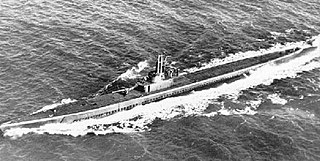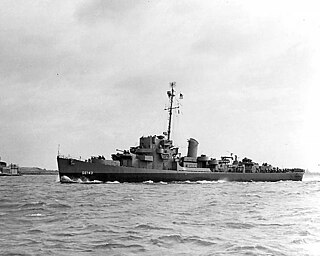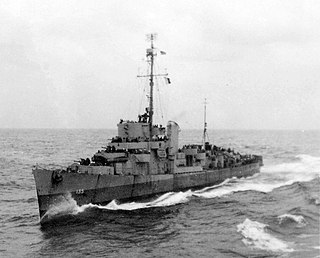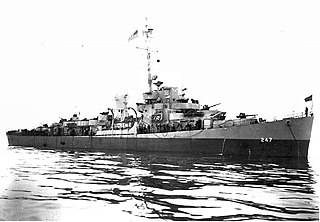
USS Reuben James (DE-153) was a Buckley-class destroyer escort in the United States Navy. She was the second ship named for Reuben James, a Boatswain's Mate who distinguished himself fighting the Barbary pirates.

USS Shark (SS-314), a Balao-class submarine, was the sixth ship of the United States Navy to be named for the shark, a large marine predator.

USS Croatan (CVE-25) was a Bogue-class escort carrier launched on 1 August 1942 by the Seattle-Tacoma Shipbuilding Corporation of Seattle, Washington, under a Maritime Commission contract; sponsored by Mrs. J. S. Russell; and commissioned on 28 April 1943.

USS Flasher (SS-249) was a Gato-class submarine which served in the Pacific during World War II. She received the Presidential Unit Citation and six battle stars, and sank 21 ships for a total of 100,231 tons of Japanese shipping, making her one of the most successful American submarines of the War. She was the first ship of the United States Navy to be named for the flasher.

USS Seahorse (SS-304), a Balao-class submarine, was the first submarine and second ship of the United States Navy to be named for the seahorse, a small fish whose head and the fore part of its body suggest the head and neck of a horse.

USS Barber (DE-161/APD-57) was a Buckley-class destroyer escort in service with the United States Navy from 1943 to 1946. In 1969, she was sold to Mexico where she served until 2001.

USS Otter (DE-210), a Buckley-class destroyer escort of the United States Navy, in service from 1944 to 1947. She was finally sunk as a target in 1970.

USS Atherton (DE-169), a Cannon-class destroyer escort, was the only ship of the United States Navy to be named for Lt. (jg) John McDougal Atherton, who died when USS Meredith sank near Guadalcanal during World War II.

USS Fiske (DE-143) was an Edsall-class destroyer escort built for the United States Navy during World War II. Named for Rear Admiral Bradley Allen Fiske, she was the first of two U.S. Naval vessels to bear the name. The vessel entered service in 1943 and served in the Atlantic Ocean during World War II as part of a hunter-killer anti-submarine group. On 2 August 1944, Fiske was sunk by a torpedo fired by the German submarine U-804. Thirty-three of the ship's crew were killed and a further 50 were injured.

USS Huse (DE-145) was a U.S. Navy destroyer escort launched by Consolidated Steel Corp., Orange, Texas on 23 March 1943, during World War II. The ship was sponsored by Mrs. L. M. Humrichouse, daughter of Admiral Harry McLaren Pinckney Huse, whom the ship was named after and commissioned on 30 August 1943.

USS Bostwick (DE-103) was a Cannon class destroyer escort in service with the United States Navy from 1943 to 1946. In 1948, she was sold to Taiwan where she served as Taicang (DE-25). She was scrapped in 1973.

USS Bronstein (DE-189) was a Cannon-class destroyer escort in service with the United States Navy from 1943 to 1945. In 1952, she was sold to Uruguay, where she served as ROU Artigas (DE-2) until being decommissioned and scrapped in 1988.

USS Baker (DE-190) was a Cannon-class destroyer escort built for the United States Navy during World War II. She served in the Atlantic Ocean and provided escort service against submarine and air attack for Navy vessels and convoys. She returned home at war's end with a one battle star for her assistance in sinking a German submarine.

USS Pope (DE-134) was an Edsall-class destroyer escort built for the United States Navy during World War II. She served in the Atlantic Ocean and provided destroyer escort protection against submarine and air attack for Navy vessels and convoys.

USS Flaherty (DE-135) was an Edsall-class destroyer escort in service with the United States Navy from 1943 to 1946. She was sold for scrap in 1966.

USS Fessenden (DE-142/DER-142) was an Edsall-class destroyer escort built for the U.S. Navy during World War II. She served in the Atlantic Ocean and the Pacific Ocean and provided destroyer escort protection against submarine and air attack for Navy vessels and convoys.

USS Snowden (DE-246) was an Edsall-class destroyer escort built for the U.S. Navy during World War II. She served in the Atlantic Ocean the Pacific Ocean and provided destroyer escort protection against submarine and air attack for Navy vessels and convoys.

USS Stanton (DE-247) was an Edsall-class destroyer escort built for the U.S. Navy during World War II. She served in the Atlantic Ocean the Pacific Ocean and provided destroyer escort protection against submarine and air attack for Navy vessels and convoys.

USS Swasey (DE-248) was an Edsall-class destroyer escort built for the U.S. Navy during World War II. She served in the Atlantic Ocean the Pacific Ocean and provided destroyer escort protection against submarine and air attack for Navy vessels and convoys.

Operation Teardrop was a United States Navy operation during World War II, conducted between April and May 1945, to sink German U-boats approaching the Eastern Seaboard that were believed to be armed with V-1 flying bombs. Germany had threatened to attack New York with V-1 flying bombs and rocket U-boats. After the war, it was determined the submarines had not been carrying either.




















